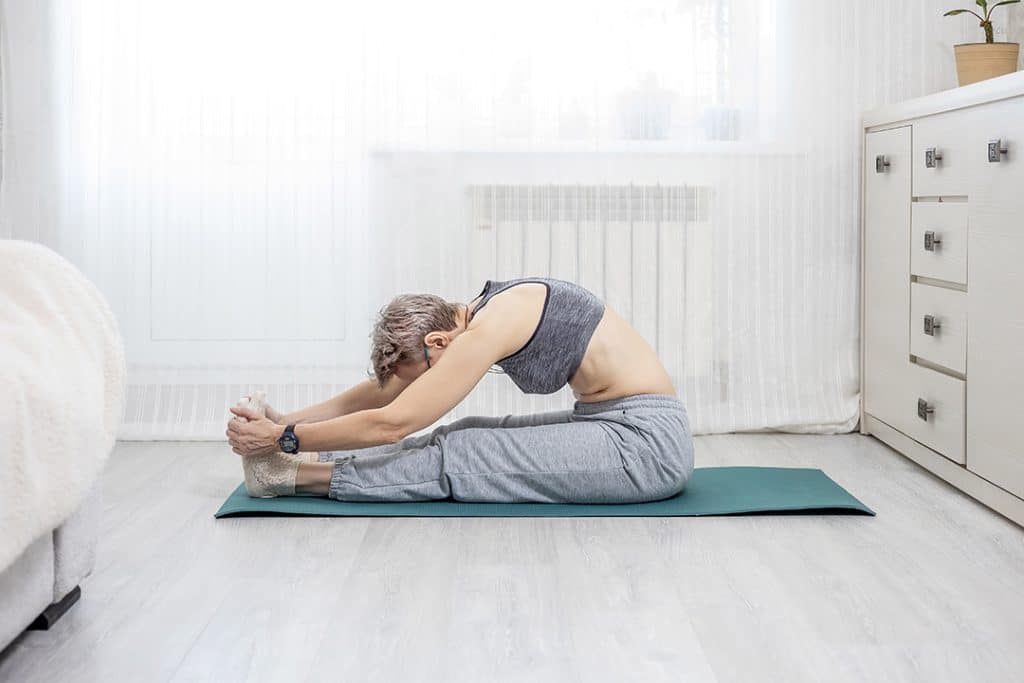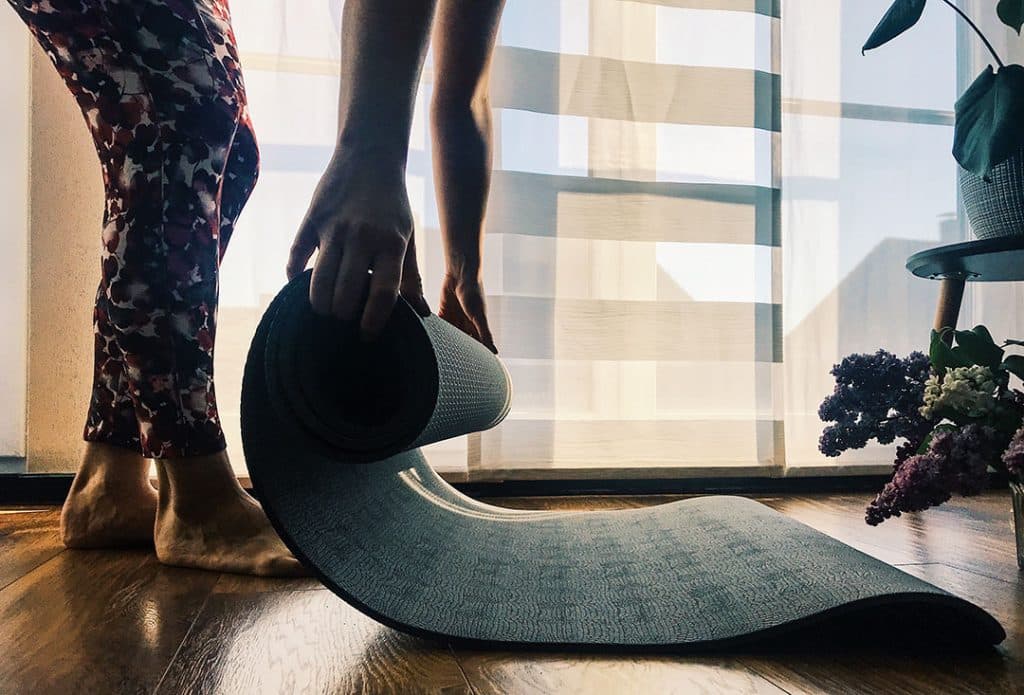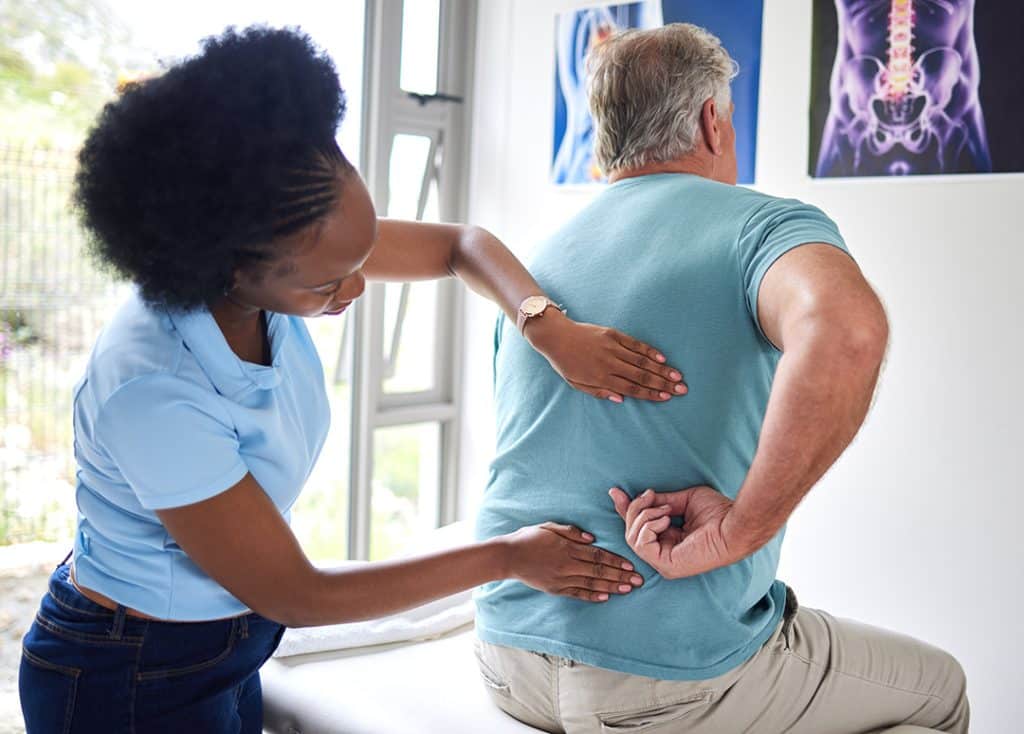Keeping your lower back mobility strong and flexible is key if you want to prevent low back pain issues in the future.
Want to enjoy being active for as long as possible? Watch your back.
Unless your low back is actively in pain, you might not think about how involved it is in almost everything you do. Bending, lifting, sitting, standing, walking, climbing – nearly every movement requires the low back to be strong and flexible.
That’s why maintaining mobility in this area is essential if you want to protect your quality of life both now and years into the future. But how can we support and enhance our low back mobility? Stretching, exercise, and chiropractic care are the best (and simplest) ways to protect your back health.
Read on to dive deeper into why low back mobility is essential and learn 8 simple daily exercises to keep your back flexible and strong.
Understanding Lower Back Mobility

Low back mobility is crucial for maintaining a healthy and active lifestyle. But did you know that a healthy back also sets the foundation for general wellness and whole-body health?
When your lower back is flexible and strong, it can support your body better, improve your posture, and reduce the risk of injuries. Moreover, a mobile lower back enhances your ability to perform daily activities and exercise without discomfort. You’ll sleep better, have better moods, and perform better – both physically and mentally.
That said, maintaining healthy low back mobility is easier said than done. Let’s take a look at the factors that could sabotage your back health and what you can do to prevent them.
The Anatomy of the Lower Back
The lower back, or lumbar spine, consists of five vertebrae labeled L1 to L5. These vertebrae are supported by muscles, ligaments, and discs that provide stability and flexibility. The lumbar spine’s unique structure allows for a range of movements, including bending, twisting, and lifting. But, this unique structure also makes the back vulnerable to several different issues and injuries:
- Vertebrae: These bones form the spinal column to give our bodies structural support. However, misalignments or degeneration of the vertebrae are common and can lead to less mobility and more pain. Vertebral conditions like scoliosis or spondylolisthesis can significantly impact your ability to move freely.
- Intervertebral Discs: These discs act as cushions between the vertebrae. They absorb shock and allow for flexible movement. Over time, however, discs become dehydrated and less flexible, which then leads to conditions like herniated discs or degenerative disc disease.
- Muscles: There are several muscles that lie along the lumbar spine, including the erector spinae, multifidus, and quadratus lumborum. These work together to support and stabilize your lower back. If these muscles become weak or tight, it can lead to poor posture, reduced mobility, and an increased risk of injury.
- Ligaments: Ligaments connect the vertebrae and give the spine more stability. If these ligaments get strained, inflamed, or injured, it can cause pain and reduce your lower back’s mobility. Ligament injuries like this often result from sudden movements or heavy lifting without proper form.
- Nerves: The lumbar spine houses the nerves that transmit signals between your brain and lower body. Compression or irritation of these nerves (like sciatica) can lead to pain, tingling, and numbness, which will likely restrict your mobility.
Common Issues Related to Lower Back Stiffness
We’ve seen how issues can arise based on where your low back is weak, vulnerable, or overstrained. But what causes those anatomical issues in the first place?
- Muscle Strains
Overstretching or tearing muscles in the lower back is a quick way to cause pain and stiffness. This often results from heavy lifting, sudden movements, overexercise, or long periods of poor posture. - Herniated Discs
A herniated disc is when the soft center of a spinal disc pushes through a crack in the tougher exterior casing. This protrusion irritates nearby nerves and causes pain, numbness, and stiffness. - Sciatica
Sciatica occurs when the sciatic nerve gets compressed, usually due to a herniated disc or bone spur pressing on the nerve’s origin in the low back. It can cause sharp pain, tingling, and stiffness radiating from the lower back down to the legs. - Arthritis
Osteoarthritis in the spine can lead to stiffness, swelling, and reduced range of motion due to the degeneration of cartilage between the spinal joints. - Poor Posture
It’s easy to neglect our posture, but consistently slouching or sitting improperly will strain the muscles and ligaments in your lower back and leave you feeling stiff and uncomfortable. - Sedentary Lifestyle
Objects in motion stay in motion – so if you want to maintain your mobility, it’s best to keep an active lifestyle. A lack of physical activity weakens the muscles supporting your spine over time, and causes stiffness and increases your risk of injury. - Spinal Stenosis
With spinal stenosis, the spinal canal becomes too narrow and puts pressure on the spinal cord and nerves. This causes pain, stiffness, and overall reduced mobility.
Other Factors Affecting Low Back Mobility
Beyond anatomical issues and injuries, there are several factors that influence how flexible or stiff your low back is. Here are the most common factors:
- Your Age
As you age, the discs in your spine naturally lose hydration and elasticity, which can reduce mobility and increase stiffness. Staying hydrated, eating a healthy diet, and taking supplements to protect the discs and slow this process can help. - Physical Activity Levels
Regular exercise helps keep the muscles and ligaments around your spine strong and flexible. On the other hand, a lack of exercise can lead to muscle weakness and stiffness. To maintain your mobility, you must stay active! - Your Lifestyle
As with any health issue, lifestyle plays a huge role in your back mobility. Habits such as smoking and poor diet choices can increase inflammation and deteriorate the health of your spinal tissues. This then reduces their ability to repair, regenerate, and stay supple. - Your Weight
Excess body weight can impact your health in many ways – from stressing your cardiovascular system to straining your lower back. Returning to a healthy body weight can take loads of pressure off your spine and leave you feeling more energized and active. - Your Posture
Good posture helps distribute weight evenly across your spine, which reduces strain and stiffness. Poor posture, however, can lead to muscle imbalances and increased tension in the lower back. - Your Occupation
Does your job involve heavy lifting, prolonged sitting, or repetitive motions? Unfortunately, these can negatively impact low back mobility. Don’t worry, you don’t have to quit to save your back, but making a few ergonomic adjustments and taking regular breaks can help reduce the negative effects.
The Benefits of Maintaining Lower Back Mobility

It’s obvious that having great low back mobility would be good for your back health. But what about other aspects of your life? As it turns out, low back health can affect nearly all aspects of your well-being – for better or for worse. What can you expect when you start to prioritize your low back mobility?
> Improved Posture
A flexible lower back supports proper alignment of the spine, which keeps your posture in good shape. Good posture then reduces the strain on your back muscles and joints, preventing pain and discomfort.
> Fewer Injuries
A flexible lower back can mean more resilient muscles and ligaments around your spine. This added strength reduces the risk of injuries, especially during physical activities and sports.
> Enhanced Flexibility and Range of Motion
Increased flexibility and range of motion in your lower back enable you to move more freely. This can make daily tasks easier and more comfortable, from tying your shoes to reaching for objects on high shelves. Enhanced flexibility also means you can take on more challenging activities, like going on more adventurous hikes or trying new sports.
> Relief from Lower Back Pain
A stiff back is the precursor to a painful back. By improving mobility, you can reduce the frequency and severity of lower back pain episodes.
> Improved Mood
Pain and immobility aren’t just uncomfortable – they can wreak havoc on your mental health over time. By maintaining low back mobility, you can prevent chronic pain-related stress and boost your mental health. Plus, physical activity releases endorphins, which are natural mood lifters. With a mobile, flexible, strong back, you’ll be able to stay active and de-stress.
> Better Sleep
It’s no surprise that chronic back pain and stiffness can interfere with your sleep. By improving low back mobility and reducing discomfort, you can enjoy more restful and uninterrupted sleep. Better sleep, in turn, enhances your overall health, mood, and overall productivity.
> Enhanced Digestion
You may be surprised to hear that a healthy low back can lead to better digestion, but in reality, these two areas are closely connected. Your spine’s alignment can influence how efficient and comfortable your digestion is. How? Poor posture and a stiff back can compress your digestive organs, which can lead to issues like constipation and indigestion. By maintaining good low back mobility, you can help ensure that your digestive system functions smoothly.
> Increased Energy Levels
When your back is in good health, your body can move easily and freely, reducing the amount of energy required for movement. This means you’ll feel less fatigued throughout the day and have more energy to engage in activities you enjoy.
8 Simple Exercises for Lower Back Mobility
Feeling inspired to boost your back health with mobility exercises? Knowing all the potential benefits of low back mobility, let’s shift into what you can start doing today to ensure a mobile back for years to come.
Warm-Up Exercises

Do you skip warm-ups before a workout? You could be sabotaging your back health. Warming up increases blood flow to the muscles and joints, making them more flexible and ready for exercise. Along with reducing the risk of injury or strain, warm ups also improve your overall performance so you can reach higher goals and get more out of exercise. Try these:
1) Cat-Cow Stretch
- Get on your hands and knees in a tabletop position.
- Inhale, arching your back and lifting your head and tailbone (Cow Pose).
- Exhale, rounding your spine and tucking your chin and pelvis (Cat Pose).
- Repeat for 1-2 minutes.
2) Pelvic Tilts
- Lie on your back with your knees bent and feet flat on the floor.
- Flatten your lower back against the floor by tightening your abdominal muscles.
- Hold for a few seconds, then relax.
- Repeat for 1-2 minutes.
Core Strengthening Exercises

Core strength is a superpower. A strong core supports your lower back and improves overall stability, allowing you to move optimally and pain-free. Try these:
1) Bridge Exercise
- Lie on your back with your knees bent and feet flat on the floor.
- Lift your hips towards the ceiling, squeezing your glutes and engaging your core.
- Hold for a few seconds, then lower back down.
- Repeat 10-15 times.
2) Bird-Dog
- Start in a tabletop position on your hands and knees.
- Extend your right arm forward and left leg backward, keeping your back straight.
- Hold for a few seconds, then return to the starting position.
- Repeat on the opposite side.
- Perform 10-15 repetitions on each side.
Flexibility and Stretching Exercises

Stretching and flexibility exercises are key to improving the elasticity of your muscles and the range of motion in your joints. This helps maintain and even build your mobility while reducing stiffness in the lower back. Try these:
1) Knee-to-Chest Stretch
- Lie on your back with your knees bent.
- Bring one knee up to your chest, holding it with both hands.
- Hold for 20-30 seconds, then switch legs.
- Repeat 2-3 times on each side.
2) Seated Forward Bend
- Sit on the floor with your legs extended straight in front of you.
- Slowly reach forward towards your toes, keeping your back straight.
- Hold for 20-30 seconds.
- Repeat 2-3 times.
Mobility and Rotation Exercises

Mobility and rotation exercises enhance the flexibility of your spine and improve the range of motion. They help you perform twisting and bending movements with ease. Try these:
1) Spinal Twist
- Sit on the floor with your legs extended.
- Bend your right knee and place your right foot outside your left thigh.
- Twist your torso to the right, placing your left elbow outside your right knee.
- Hold for 20-30 seconds, then switch sides.
- Repeat 2-3 times on each side.
2) Windshield Wipers
- Lie on your back with your knees bent and feet flat on the floor.
- Slowly drop both knees to one side, keeping your shoulders on the floor.
- Hold for a few seconds, then return to the starting position and drop to the other side.
- Repeat for 1-2 minutes.
How to Incorporate Low Back Exercises into Your Daily Routine

Mobility requires consistency – doing a few exercises or stretches just once in a while won’t do much for your long-term goal of maintaining a healthy, active lifestyle. To develop a strong, flexible, mobile low back, make time to practice mobility every day (or at least several times a week). Here’s how…
Make Mobility a Stress-Free Daily Routine
- Set a Schedule: Choose a specific time each day for your exercises to make it a habit, such as in the morning.
- Start Slow: Begin with a few exercises and gradually increase the duration and intensity.
- Mix It Up: Combine different types of exercises to keep your routine interesting and balanced.
Safety Tips and Precautions
- Always warm up before exercising to prevent injuries.
- Listen to your body and avoid pushing through pain.
- Talk to your healthcare professional if you have any existing conditions or concerns.
Leverage Chiropractic Care to Boost Mobility
Regular chiropractic care is a fantastic complementary self-care habit to your mobility exercise routine. Chiropractic focuses on maintaining the proper alignment of your spine, which also supports the nearby muscles, ligaments, and tendons that can lead to poor posture or low back pain.
Beyond that, chiropractic care can also help identify and correct potential issues to help you steer clear of mobility or pain conditions in the future, and help you determine which exercises are best for your back.
Maximize Your Low Back Mobility for an Active Future

Maintaining low back mobility is essential for a healthy, active lifestyle. By incorporating simple exercises into your daily routine, you can improve your posture, reduce the risk of injury, and prevent lower back pain.
But remember, consistency is key! Combining these exercises with a healthy lifestyle and regular chiropractic care can help you move closer to your health and wellness goals.
Ready to enhance your mobility? Schedule a visit with your AlignLife Center today to boost your back health and stay moving!



